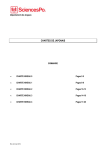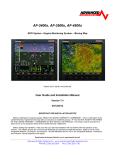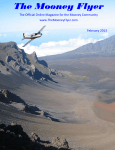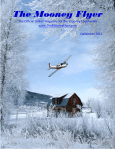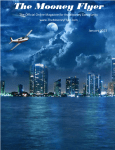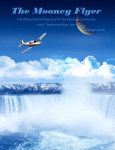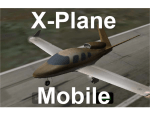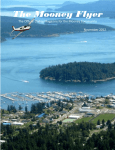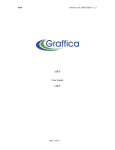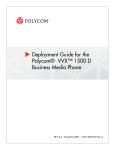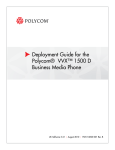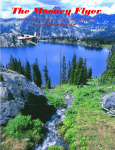Download From The Editor From the Editor
Transcript
The Mooney Flyer Volume 1 Number 3 July 2012 www.vintagemooneygroup.com Table of Contents From the Editor Mooney Mail Ask the Top Gun From The Editor The Future of Mooney Aircraft Mooney Rigging Engine Trouble over the Nevada Desert What Would Steve Canyon Say? Upcoming Fly-Ins ADSB Garmin aera 796 Review Classifieds From the Editor Welcome to our 3rd Mooney Flyer Newsletter. Thanks for all of your wonderful feedback to our second edition. It’s what makes the entire Mooniac community fantastic. We are already listening to your feedback, providing original articles that are relevant to us Mooniacs. Last month, we created online interactive versions to provide the value of your vintage Mooney using Jimmy Garrison’s model. It will be kept up to date each time Jimmy revises his estimates. This past month, I got the opportunity to host a camping fly-in to beautiful Columbia, CA (O22). We expected 3-4 Mooneys to show up. Many co-pilots think of camping as staying at a Holiday Inn Express instead of a Hilton. But we had a dozen (12) Mooneys participate from California, Nevada, Oregon, and even a Mooney from North Carolina (Editor note: They were already in California). The camaraderie was fantastic. We had a BBQ on Saturday and then enjoyed the historic Gold town of Columbia, shared a few rounds while an old timer played the piano, and then told ghost stories that evening over a rip roarin’ fire. We apparently were having enough fun that several other camping aviators joined us. Owning and flying a Mooney is about as good as it gets! But the camaraderie with other Mooniacs just makes it that much more enjoyable. 1 The Mooney Flyer Volume 1 Number 3 July 2012 We’ve added a couple of new Columns, which will be regular features in the Newsletter. The first is Ask the Top Gun. In this column, Top Gun Aviation founder, Tom Rouch, will answer your Mooney questions. Tom is regarded as one of the most knowledgeable individuals in the Mooney community. Take advantage of his expertise. Send us a question and we’ll do our best to post the answer. The second addition is a Mooney Classified Ads section. If you are a subscriber, your ads are placed for Free for the time being. Just send us the info. In this issue, we have some real interesting stuff for your consumption. We kickoff with an analysis of a scenario for the Mooney Factory to come back to life entitled The Future of Mooney Aircraft. There have been many sentiments that Mooney should bring back the M20J. And as has been said many times, a new J would cost almost as much as an Acclaim to build. But what about a “crawl-walk-run” strategy for the factory where Mooney refurbishes old J’s with a new engine, new paint, new interior, and new panel and sells it with a factory warranty? Bob Kromer writes up this possible scenario and then we solicit your input via our interactive polls. This month, we add an article by Paul Loewen, founder and owner of LASAR. The article is called How do I know if my Mooney is rigged properly? Who is better equipped to answer this question than Paul! It was a good day to fly… It was a bad day to fly. The pre-flight and runup went well, but things were not well. We have a first person story from Mooney owner Greg Jacobs who suffered an engine problem over the desert in Nevada. It’s titled “Engine Trouble Over Nevada”. He glided 17 miles from about 8000 AGL with two souls on board. A great read. In this issue, Jim Price gives you “Everything You Need to Know about ADS-B”. This emerging technology is starting to be deployed. There is limited weather (which will not have any subscription fee) and traffic information. There are some devices becoming available that let you tap into traffic and weather today. Read about it in Jim’s article. If we didn’t answer your questions, send us an email to the Editor and we’ll do our best to get those answers in the next edition. This month we reviewed the “Garmin aera 796”, the so called iPad Killer. Well, it’s a cool device, but it is no iPad Killer. The unit is very cool, but it is significantly more expensive than an iPad and the database subscriptions are also significantly more than iPad subscriptions from ForeFlight. Nonetheless, it has some very nice features which we have tried to present. We also have a little fun with “What Would Steve Canyon Say”. This light hearted piece deals with things that pilots say on frequency that just might not be correct. This is all in fun. Please feel free to send us any of your personal experiences. Mooney Model Chronology Did you ever want to know the differences between each Mooney Model, differentiated by serial number? Here’s a cool link that enumerates every change. Click Here In keeping with Mooney “Baggage Door” folk lore, there is an ongoing discussion, or debate, about whether or not you should lock your baggage door before departing. Stories have been told of the door opening in flight, separating from the fuselage, and doing signficant damage to the empennage. We cannot verify these stories, but provide you with some facts and information on the pros and cons of locking your baggage door. 2 The Mooney Flyer Volume 1 Number 3 July 2012 Some Aircraft Oil Stuff Aircraft engines don’t wear out, they rust out Dark & opaque oil represents blow-by Mineral oil suspends particles better and seals better than synthetic Use 2/3rd of oil capacity to reduce blow-by When you open the filter, if the particles crack in your hand, it’s carbon, not metal. Oil lab analysis is only useful after establishing trends Results for Flight Following Poll Don’t forget about our cool new Appraise your Mooney’s Value using Jimmy Garrision’s valuation. Jimmy is from All American Aircraft, the country’s largest Mooney reseller. We have implemented the models for M20C, M20E, M20G, M20F & M20J. Click on your model to simply complete the valuation. You no longer need paper and pencil. Just another benefit to our subscribers. These forms are currently Beta test quality. Please send errors to us. M20C M20E M20G M20F M20J updated June 2012 Pilot Bill of Rights Passed in Senate -- Senator James Inhofe’s Pilots' Bill of Rights passed the Senate Friday. The bill includes protections for pilots who become the subject of FAA enforcement proceedings and also requires the FAA to take actions regarding NOTAMs and the agency's medical certification process. Regarding NOTAMs, the bill requires the FAA undertake a NOTAM Improvement Program. That program requires simplification and archival of NOTAMs in a central location. The idea is to ensure pilots can easily acquire the most relevant information through the system. Regarding medicals, the bill requires that the GAO review the FAA's process and forms with the goal of creating greater clarity in the questions and fewer allegations of intentional falsification against pilots. The effort will be accept advice from an advisory panel made up of "non-profit general aviation groups." Details about the pilots' bill of rights include requirements that the FAA grant a pilot relevant evidence 30 days before deciding to proceed with an enforcement action. It also allows pilots to seek Federal district court review of appeals from the NTSB. That means pilots can introduce evidence and get "a new review of the facts." 3 The Mooney Flyer Volume 1 Number 3 July 2012 Mooney Mail Another hit! This is an awesome publication. I hope the vendors listed are paying for the ads. They are getting great coverage and the display is better than some high cost magazines. Dave Rubinger N1357W Very nice newsletter! I like the interactive forms, especially the valuation one. Well done. Jeff Schlueter Well done guys, I have enjoyed both issues immensely! Bodie Bell How Long do the Landing Gear Biscuits Last? There are three things to check for when determining the condition of the shock discs: 1. Look for cracks in the rubber indicating they are getting hard from age. 2. Jack the aircraft and see if the discs expand to keep the gear tight. When first jacked, try to move the a main gear fore and aft. It should be solid and not movable. If you can move the gear, then wait a few minutes and try again. If the gear are now tight then the discs are too slow to expand and should be changed. If the discs do not expand you can now imagine the shock on the wings on landing with a gap between the discs and the disc collar. The shock can, over time induce fuel leaks. 3. When jacked, depending on the model, you are allowed a gap between the collar and top disc. Check your Service Manual for the gap allowed on your model. There is no gap allowed on the nose gear on any model. 4. On the heavier long bodies, we have had to change some discs in as short a time as two years. The lighter the models, like a C, can go quite a few years. Hangering and heat are the variables affecting the discs. What is the correct method to perform Corrosion Maintenance? We recommend a treatment every few years. Needs may vary, depending on the local conditions, whether the aircraft is kept in a hangar, etc. However, a good look inside the wings, fuselage, etc., should give a good clue as to need. The inspection should be done by someone who can determine types of corrosion. We use Boeshield and have the equipment, different spray wands, etc. to properly spray. For years we used Corrosion X which is very good but tends to seep thru rivets making the wings unsightly. The Boeshield has a wax base so it does not weep. The average cost is about $250, and of course varies by the size of the aircraft and how much we access. A C-210 for instance is a lot of work. This all should be done just before closing at Annual to mitigate the time. 4 The Mooney Flyer Volume 1 Number 3 July 2012 The Future of Mooney Aircraft Corporation by Bob Kromer Mooney Executive Vice President and General Manager 1986-1991 Mooney Engineering Test Pilot 1983-1986 Mooney Aircraft Pilots Association Executive Director 1997-2000 It is with great interest that those of us with passion and loyalty to Mooney airplanes have followed the status of the Mooney factory in Kerrville. Not only from a vested interest in the need for spare parts, but also from a perspective of “Can the factory make a comeback?” It might be tempting, but making a return by building new Mooneys with price tags well north of $500,000 seems to be the wrong strategy. That market is saturated - and expensive. Unfortunately, those prices are a reality in today’s world of building, selling and supporting new high performance, single-engine airplanes. Can’t there be something better than this for the Mooney factory to return from its current state of inactivity? There might be. During my tenure at the Mooney factory, we looked very closely into the idea of refurbishing existing Mooney airplanes to like-new condition. In the back door would roll a 2000-3000 hour Mooney and out front door would roll a like-new Mooney. Everything would be new on the airplane, done at the factory by the very same people who built it. New paint, interior, glass avionics, engine, propeller, resealed fuel tanks and numerous systems updates. The only item not zero-timed would be the airframe, but it would be carefully inspected and any structural discrepancies would be corrected. Except for the time on the airframe, the airplane would look, smell and fly like new. A 12 month spinner-to-tail warranty would also be included. We didn’t execute this refurbishment strategy in the late 80’s and early 90’s because we were still building new airplanes. Frankly, the refurbished airplanes would be too much competition for the new ones. The refurbished airplanes would have identical performance and features at one-half the price. Say goodbye to new airplane sales. But the factory today is idle. It doesn’t build new airplanes. Its doors and floor space are open for a new business direction. The time has never been better for executing a factoryrefurbishment program. In the majority of my time in Kerrville, we built the M20J and the M20K (252). Two wonderful airplanes. As Mooney’s engineering test pilot from ’83- ‘86, I always felt these two airplanes represented the optimum combination of Mooney airframe and engine size. Flight test data always confirmed this. More powerful engines are always nice, but with fuel prices high and going higher, there’s a lot to be said for those superefficient 201 and 252 models. I have been discussing this M20J and M20K factory refurbishment idea with Phil Corman. He is enthusiastic, but questions remain. What’s the best (but realistic) price point for a factory-refurbished, likenew M20J? How about an M20K? Are these, in fact, the correct models for the factory refurbishment program? Glass or mechanical instrumentation and avionics? New or overhauled engines? Phil has put together a short questionnaire that will hopefully discover some answers to these questions. Your help is highly coveted and appreciated. And, it will create jobs for a great group of former employees who know and love Mooney airplanes as much as anyone. If you have the time, please answer the questions and give us your thoughts. It would really be appreciated. 5 Click Here to take the Poll on The Future of Mooney Aircraft Co. The Mooney Flyer Volume 1 Number 3 July 2012 How Do I know when my Mooney is rigged Correctly? ANSWER: Most airplanes need to be re-rigged from time to time. By Paul E. Loewen, I.A., A & P, Chief Inspector, Lake Aero Styling & Repair Annual Inspections and 100 Hour Inspections usually include a check of the flight controls and the travel limits of the moveable surfaces; i.e. ailerons, flaps, elevators, rudder and stabilizer (trim). This is done with a "travel board", (a Mooney GSE tool) that is required to easily measure the travel to Service Manual specifications. When the Mooney is raised on jacks, you can see the affect of the inter-connect of the ailerons and rudder and nose gear steering, as if in flight. There are interconnect springs and centering bungees that neutralize the flight control’s static, while servo tab adjustments of the ailerons and rudder trim the airplane dynamically (in flight). The static rigging can be adjusted and set to specifications in the shop, and dynamically rigging is adjusted incrementally after a series of flight test by bending the trailing edges or servo trim tab on the rudder and ailerons. The goal to be achieved on airplanes is to cruise hands off, autopilot disengaged, with the wings level and the ball centered in the turn coordinator. Banking left and right with the use of the rudder pedals alone and returning to neutral proves correct rigging. Extension of flaps should not cause the airplane to bank either, although it might want to momentarily, as the flaps move off the "up stops", due to the flexing of the flap torque tube interconnect in the fuselage. The Mooney should continue to fly hands off (wings level) with the flaps in the 15 degree take off position or 33 degree landing position. Touch down at landing should occur with no adverse yaw, as the nose wheel makes contact with the runway (no crosswind condition). The stall strips fixed on the leading edge of the wing are positioned at the factory during flight test to assure that the wing stalls correctly straight ahead without falling off to the right or left. These strips are there to fine tune the wing from variations of fabrication. I'm told the same fine tuning could be achieved by shaping the left or right wing leading edges with a rolling pin (kitchen item). This is a difficult procedure and not a very practical method on a production line. A wing that has had some major repairs may require adjustment and repositioning of the stall strips as well as the aileron rigging described here. Flaps should almost always be rigged equal at 33 degree, 15 degree, and 0 degree settings. Ailerons should be rigged static to -2 degrees down from neutral and checked to reach 0 degrees by lifting up on both sides together as aerodynamic forces cause them to in flight. Wing heaviness is corrected by proper adjustments to the ailerons and rudder trailing edges or tab, (not the asymmetrical rigging of flaps settings). Sighting the trailing edges of the rudder and ailerons should be done to confirm their present conditions. Aileron trailing edge should be at neutral or only the left or right bent down only, i.e., a condition of both ailerons trailing edge "bent down" would not be good as it would 6 The Mooney Flyer Volume 1 Number 3 July 2012 cause the control pressures of the control wheel to be very stiff to operate. This might be confirmed visually by looking at the ailerons in flight, and seeing both raised above neutral. A trailing edge bent up is not effective or proper. A slight bending of the trailing edge of the outer 12" or so is done with a set of wide jaw vice grip pliers, and is very effective. Bending "down" causes the aileron to raise, which causes that wing to "lower”, bringing the heavy side "up". So you must determine which aileron to bend. Another difficulty may be encountered if the flaps or ailerons have had damage or have been poorly repaired. A trained eye comparing the left or right side controls may detect a warped or bowed flap or aileron. Some control surfaces have even been manufactured in a slight warp, which makes it difficult to rig using the aid of the travel board, and really giving you a false reading on one end. A warped flap or aileron can be detected by viewing the surface by standing in front of the wing. If it appears "evenly" visible it's probably OK, and can be reconfirmed by sighting down the trailing edge, viewing from the wing tip. In the case of a warped flap, a compromise of rigging could be obtained by adjusting the flap by trial and "air". Nose wheel rigging, to prevent yawing or darting left or right on touchdown, can be corrected by clamping the right rudder pedals to neutral and sighting the nose wheel from the tail of the Mooney. Adjusting the Heim link to the rudder pedal torque tube arm and nose gear, longer or shorter, will center the nose wheel. This is a good time to check the rudder neutral position and travel limits with a rudder travel board placed on the side of the vertical stabilizer, and with the nose wheel raised off the ground, a check of the neutral position is verified to be 0 degrees - 0 + 1 degree right and that the travel limits left and right are equal and correct. Often someone has misadjusted the visible Heim rod end on the rudder horn which makes the travel limits uneven. This Heim must be readjusted to correct the travel limits and a push rod in the forward belly adjusted to set the neutral position. A check of the rudder travel should be rechecked with the wheels retracted. (Be sure to jack up the airplane before retracting. Often there could be problems encountered with the assembly of the steering horn on the top of the nose gear that could limit full rudder travel in flight. It's best to find these problems on the ground. 7 The Mooney Flyer Volume 1 Number 3 July 2012 Obviously, what I have described should be accomplished by a qualified Mooney mechanic who isusing proper tools, travel boards, and a Mooney Service Manual. Your flight evaluation may determine your need to have this rigging procedure accomplished. Unequal fuel loads or "pilot only" really have little affect on these flight test procedures. A correctly rigged Mooney wing may result in one aileron flying higher than the other to compensate for heaviness, and that may be normal for that airplane. A Weighty 100LL Fact We were all told that 100LL weighed 6lbs. Well, we found out that it actually weighs 5.82lbs. So what? Well, for a 50 gal tank, that’s 9 lbs of useful load, and 18 lbs for a long body. Not impressed? Well, just don’t tell my wife! Try a thing you haven't done three times. Once, to get over the fear of doing it. Twice, to learn how to do it. And a third time to figure out whether you like it or not." --Virgil Thomson, American composer and critic 8 The Mooney Flyer Volume 1 Number 3 July 2012 Engine Trouble in the Nevada Desert by Greg Jacobs A good Mooney friend of mine told me that nobody knows if they are a good pilot until they are tested. Well, on October 19th, 2003, I was tested. My good friend Bob and I departed Sedona, Arizona for the final leg of a 10 day cross country trip. We were looking forward to our final landing at Hayward, California, after a very long trip covering many miles and flying hours. Our departure from Sedona was uneventful. We were westbound at 8,500 feet and the Colorado River was off in the distance with Bullhead City, Arizona south of our course on the east side of the river and Laughlin, Nevada on the west. Shortly after crossing the Colorado River things were no longer uneventful. An Excerpt from Bob’s Personal Journal “We had the charts spread out across both of our laps,and it happened! Without warning, the engine stumbled and banged and emitted a woeful stuttering, clanging noise. The whole airplane was shaking. In one motion, Greg swept the chart from our laps, into the back seat. He slammed the mixture control to full rich, pushed the prop control to full pitch, switched the magnetos, changed fuel tanks, turned on the fuel booster pump – all with no change. All this happened in maybe ten seconds, but it seemed much longer. The engine was stumbling, screeching and coughing out its guts. The prop had slowed to the point where I thought I could see individual prop blades instead of the invisible blur under normal power. We were losing altitude and shaking like rag dolls. Greg said, “We’re turning back”. Now My (the pilot) Perspective: Continuing to the west all was good until that sound that you never want to hear at any altitude. First it was just a shudder with some vibration. My training kicked in and I “willed myself” to be calm and rational. I went for the throttle….full….then the fuel tank…..switch to the opposite tank…. now the fuel boost pump…..on……prop…….full…..magnetos…..check left and right and back to both. Nothing changed. The shutter and vibration grew worse. 9 The Mooney Flyer Volume 1 Number 3 July 2012 We were 17 miles northwest of the Bullhead City/Laughlin Airport (KIFP). The closest airport, Searchlight (1L3), was directly ahead about 10 miles. However 1L3’s elevation was higher (3,400 feet versus 701 feet at IFP), and the runway was shorter, (5,040 feet versus IFP’s 7,500 feet). Within the first minute I knew the Mooney would make Laughlin, so I elected to go where the services were better, the runway was longer and the pavement condition was new. With the RPM significantly reduced, the vibrations were much less. The Laughlin airport elevation is about 700 feet and I’m at 8500 feet. From the chart above, you can see that I could glide about 16 miles. The wind would be at my back, aiding the glide distance and the airplane had some momentum because I had maintained altitude while slowing the airplane to best glide speed. The glide to the airport was calculated to be about 10-12 minutes. It was the longest 10-12 minute of our lives. By the way, on my old hand held Garmin 195 GPS the engine out location was permanently marked with a Glider Icon. After turning to the airport and stabilizing the airplane, I called the Bullhead/Laughlin tower and told them about my situation. It had to have been much longer than 10-12 minutes to the airport but we finally arrived with an extra 1000 feet of altitude. I told the tower I was doing a 360 to lose altitude and would call back upon completion of the 360o. As I turned back onto final, the tower directed another airplane off the runway and gave me clearance to land. Still a bit high, I did a few “S” turns followed by a few side slips to assure making the runway. We touched down smoothly only to watch the propeller stop at the 1 o’clock position shortly after touch down. We coasted off the runway at the mid-runway taxiway. Bob’s words: It is not that things happened very quickly. It is that things happened instantaneously. At one moment we were humming along happily through the air, the next moment we were faltering and shaking and knew we were in serious trouble. At one moment we were peaceably content, knowing we would be home in a few hours, the next moment we were flushed with adrenaline, not knowing what the next few minutes would bring us. 10 The Mooney Flyer Volume 1 Number 3 July 2012 Greg radioed Bullhead City that we had an engine failure and requested a straight in approach. In our favor, we had nearly 8000 feet of altitude under us. Bullhead City was seventeen miles away. We had enough altitude to make the airport if nothing else went wrong. The tower appreciated the seriousness of our situation and approved a straight in approach. As we got nearer, they would cease normal operations so that we could make whatever maneuvers might be necessary to save our butts. After the initial engine failure, the engine continued to make diminished power for about thirty seconds. After that, there was nothing except unholy clanging noises and vibration. If the propeller is not pulling you through the air, then it “windmills” as your momentum pushes it through the air, which diminishes the airplane’s glide ratio. If the engine is not turning the propeller then the propeller is turning the engine against its will, quickly leading to more serious engine damage. It felt like we were dropping like a brick, much faster than any normal descent. We were no longer flying an airplane, but a nose-heavy, inefficient glider. So far, though, it looked like we could still make it. The distance to the airport, which we could see on the horizon, seemed to grow farther as time passed. We were in some strange kind of parallax distortion. It must have been the adrenaline playing games with my mind. Intellectually, I knew time was passing and that we must be getting closer to the airport, but with every minute it seemed ever further away. My life was flashing before my eyes. After eighteen years attendance at the Reno Air Races, I have witnessed probably a hundred emergency landings and seen pilots in much more dire circumstances than we, safely land their planes. I knew Greg could handle this landing, I just had my doubts that we would ever get to the airport. As it turned out, we arrived over the threshold of the airport with too much altitude. Greg performed a 360o degree spiral to bleed off some height, then made a couple of “S” turns and side slipped towards the runway as the propeller stopped turning altogether and the engine went silent. We glided noiselessly down for a landing with one prop blade standing still at the one o’clock position, coasted down the runway and onto a taxiway. Losing momentum, we slowed to a stop about a hundred feet from the runway. I congratulated Greg on the great landing. The tower called to congratulate him on an expert job of airmanship. When I opened the door to get out, I realized we were celebrities. The fire department, in a huge truck with a water cannon on the top, was bearing down on us with lights flashing and siren blaring. The fire fighter checked out the plane and arranged for a tug to come move us off the taxiway. About fifteen minutes later, the tug arrived accompanied by another fire truck. While we waited, Greg reloaded his camera and took a couple of pictures, one of me kissing the ground. They pulled the plane to a tie down spot on a lonely portion of the airport. The fire fighters then took us to the terminal so we could sort out our options. It was clear that we were not going any farther in that Mooney. 11 The Mooney Flyer Volume 1 Number 3 July 2012 Greg’s Wrap Up: The final leg of our trip was via car to Las Vegas and airline to San Francisco. This unplanned diversion to get home gave me about 8 hours to devise a plan to rescue my beautiful Mooney. The next day, I called my long time maintenance shop, LASAR, at Lakeport Ca. After telling my story LASAR’s owner, Paul Loewen, immediately had some good news for me. They were within just a few weeks of completing the rebuild of exactly the engine I would need to replace my damaged engine. Paul also knew a good mechanic in Kingman Arizona. He would ask him to take the short drive to Laughlin with his tools and remove the damaged engine from my Mooney and do the replacement of the rebuilt engine. The final engine evaluation concluded that my engine failure was due to a valve separation. I elected to drive from my home in the San Francisco Bay Area to Lakeport, pick up the new engine, deliver it to Laughlin/Bullhead City Airport, retrieve the damaged engine and take it back to Lakeport. The plan worked just as scripted. About 2 months after the incident, I took a commercial airline back to Las Vegas and a one-way car rental to Laughlin and brought my Mooney home. All ended safely and this experience gave Bob and I a story to tell over and over to anyone who would listen. I am grateful for my long range glider, I mean Mooney….that got me there safely. Here’s a new service for us Mooney owners. With Repair A Plane, you can post your repair or installation job, and receive quotes from repair & avionic shops. It’s new, but probably worth a look. Click Here to go to their website. Registration is FREE. 12 The Mooney Flyer Volume 1 Number 3 July 2012 What Would Steve Canyon Say? By Jim Price When I was in pilot training in the early seventies, we all thought we were Steve Canyon, pilot and adventurer, see http://en.wikipedia.org/wiki/Steve_Canyon All new Lieutenants wanted to be the swaggering pilot who saves the bright and beautiful girl, while sounding so cool on the radio. Perhaps we take the swaggering a bit too far when we key the mike? Here’s a little self evaluation quiz for ‘ya: 1. Do you say, "With you" when switching to a new controller? This wastes airtime and most controllers don't like it. I think there’s a 12 step program to help you break this habit. 2. Do you say, "Roger"? Responding with “Roger” doesn’t make you sound cool, any more than wearing an adult diaper makes me an astronaut. “Roger” is not a readback and it invariably results in an ATC correction. It wastes valuable frequency time. 3. Are you the guy who thinks he’s an airline Captain, and starts every transmission with "ah..." or "and..."? Forget about waterboarding. If we want results from interrogation, just make prisoners listen to this stuff on the radio. 4. Are you a TMI pilot (too much information)? At a non-towered airport, nobody needs to know that you're taxiing from the ramp to taxiway Alpha. Ask yourself, "How will this next radio call affect other pilots?" If it won't, zip it! 5. Do you use local landmarks for position reports? “Mayberry traffic, Mooney 32 Victor is over the red barn for downwind." The transient pilots are thinking, “Huh?” Position reports should be based on distance and direction from the airport. The airport aliens will thank you. 6. Do you use IFR fixes at a non-towered airport? "Slim Pickins traffic, Mooney Acclaim 7 Kilo Whiskey is over PAYED on the RNAV approach." Wonderful, you’re a handsome and or beautiful Instrument pilot. We get it. Base your reports on the runway and distance so the little people can understand you. 7. Do you modify the phonetic alphabet? SoCal approach, Mooney 6 Sugar Pop at 7,000." Don’t make up cute stuff. What’s next, Xylophone for X-ray? Un-cool, Skippy! 8. Do you ask others if they are in the traffic pattern? "Any traffic in the area please advise." This is not a capital offense, but dang close. Just monitor CTAF on #2 and get an idea of what’s going on. 13 The Mooney Flyer Volume 1 Number 3 July 2012 Upcoming Fly-Ins Mooneys and Proper Airspeeds A Mooney will not take off before it achieves the correct airspeed, and it will not land until it hits the correct airspeed. Cessnas, Pipers, Beech, etc. are all more forgiving. Mooneys need to depart and arrive on the airspeed numbers. On takeoff, if you don’t apply a little back pressure, you may wheelbarrow a little. That’s because the center of lift is moving to the back of the wing as you gain airspeed. Come over the numbers at less than 1.2Vs0 (no gusts). Full flaps are generally better than partial flaps. If you are too fast on landing, you will most likely bounce, and if you’re not careful, you will enter a porpoise. The safest thing to do on a porpoise is to go-around because you are more than likely to ding the prop on the third bounce. August 18th at Catalina Island (KAVX) Hosted by Paul Kortopates How do you slow a Mooney? Slip it, Speed Brake it, or pull the nose up. Don’t know any other method. Also in August we will be revisiting the San Juan Islands up in Puget Sound northwest of Seattle. This is a weekend fly-in but if you are local, we will have our usual ramp time together on Saturday morning followed by lunch at the airport. Make your reservations now as it is prime season on the San Juans. Some of us plan to camp at the airport on Orcas Island. Let us know if you would like info. August 24-26 at Friday Harbor (KFHR) Hosted by Jeff Mirsepasy 14 The Mooney Flyer Volume 1 Number 3 July 2012 ADS-B – What Should You Know By Jim Price The Basics (ADS-B) is an acronym for: Automatic Dependent Surveillance Broadcast In the future, ATC will track aircraft using satellites and ADS-B. It’s part of the Next Generation Air Transportation System (NextGen), which will replace our aging radar system with a satellite-based system. NextGen is more concerned with the increasingly congested flight levels and delays at major hubs, but GA must still participate. GPS and NextGen technology will be used to shorten routes, save time and fuel, reduce traffic delays, increase capacity, and permit controllers to monitor and manage aircraft with greater safety margins. Planes will be able to fly closer together, take more direct routes and avoid delays caused by airport “stacking” as planes wait for an open runway. NextGen will be implemented across the United States in stages between 2012 and 2025. With that in mind, the United States will require the majority of aircraft operating within its airspace to be equipped with some form of ADS-B “Out” capability by January 1, 2020. The rule does not mandate ADS-B “In” capability. I’ll discuss more about ADS-B – “Out” and “In” later. What, No RADAR? ADS-B will not be replacing radars anytime soon. The FAA plans to keep all long-range radars, but decommission many of the terminal short range radars at smaller airports after the 2020 ADSB mandate goes into effect. We’ll still need radar: 1. As a backup in case of GPS failure and 2. For national security. The ADS-B rule, like current transponder operating requirements, requires operators to have, at a minimum, ADS-B Out avionics installed and operating in order to fly their aircraft almost everywhere but in Class G airspace. What is the difference between ADS-B In and Out? ADS-B “Out” systems are “Report Only”. They automatically broadcast an aircraft’s GPS position to ATC about every second. The 2020 mandate is for ADS-B “Out”. 15 The Mooney Flyer Volume 1 Number 3 July 2012 ADS-B “In” systems not only broadcast/report an aircraft’s GPS position, but they also receive broadcasts from: Other aircraft, and FAA ground stations. These FAA broadcasts include: o Traffic information from other aircraft – Traffic Information Services - Broadcast (TIS-B) o Weather and NOTAM information – F light Information Services - Broadcast (FIS-B) The data received with an ADS-B “In” system is dependent on the ADS-B link and the capabilities of the receiver. Equipment Required To participate in ADS-B, you’ll need a GPS, so ATC can read your position, vector, altitude and speed. Portable GPS units don’t qualify. The GPS must be panel mounted, and the USA has mandated that the GPS have WAAS-like capability, such as the Garmin GNS 430W (shown here) or the GNS 530W. There are also newer Garmin market entries like the GTN 650, costing about $11,500 + installation, and the larger GTN 750, starting at about $17,000 + installation. Both are WAAS capable. ADS-B option 1: Install a 1090 MHz “extended squitter” (ES) transponder. “Squitter” is not a word I would have imagined to have entered my aviation vocabulary. Yet there it is, with all the distasteful images. The Garmin GTX 330 transponder with Mode S fits the bill. It’s designed for ADS-B. The GTX 330 costs about $3,500 + installation. The 1090ES is ADS-B “Out and somewhat In” capable. That is, it will receive traffic information (TIS-B)–but it will not receive weather ( FIS-B). The 1090 MHz ES link data (ADS-B “In”) allows you to broadcast the data from the GPS source to both ground stations and other aircraft in your vicinity. If your aircraft flies outside the USA or flies at or above FL 180 (18,000 feet MSL), the FAA will require you to use the 1090 MHz ES link (Mode S transponder). 16 The Mooney Flyer Volume 1 Number 3 July 2012 Aircraft and pilots that fly below FL 180 or remain in the USA, can use either option 1 (the 1090 MHz ES) or they can – Choose option 2 UAT: Install a dedicated 978 MHz Universal Access Transceiver (UAT). With a compatible UAT, you will be able to fully participate in ADS-B In. That’s because the transceiver will receive data linked weather (FIS-B) and traffic display (TIS-B) – displaying the data on your GPS’ screen. The Mode S just doesn’t have the bandwidth for FIS-B – too busy squitting about, I suppose. If you choose the UAT option, NavWorx produces the ADS600-B, a remote mounted UAT that transmits ADS-B OUT information, and receives ADS-B IN information. This will cost about $2,500 + installation. ADS-B Coverage as of Feb 27, 2012 NOT A 2020 ADS-B REPLACEMENT: A new product, aiming to take advantage of the ADS-B data linked weather (FIS-B) is the Stratus. It’s a lightweight, low-profile, battery powered (up to eight hours on a charge), ADS-B/GPS receiver that connects to the iPad completely wirelessly and provides extremely accurate GPS position in addition to ADS-B weather. It’s essentially a Wi-Fi 17 The Mooney Flyer Volume 1 Number 3 July 2012 hotspot for your iPad and ForeFlight. The Stratus costs about $800, with NO monthly fees. Click Here to read Flying Magazine’s review of the Stratus. NOT A 2020 ADS-B REPLACEMENT: A newcomer to the Wi-Fi/ADS-B weather market is the Sagetech Clarity ADS-B Receiver. It’s not on the market yet, but seeks to offer an alternative to the Stratus. Click Here to read more about its features. Projected ADS-B Coverage by the end of 2013 Puerto Rico, Guam and Hawaii will be fully covered in 2013. Note the lack of coverage below FL180 in parts of Nevada, Arizona, New Mexico, Colorado, Idaho, Kansas, Wyoming, Montana, South Dakota, and Oregon. The Bottom Line For the Class B, C and E phobic, you’re in luck, there’s always uncontrolled airspace – Class G. There are a few Class G airspace areas, shown below in tan, mostly in the west. I can’t envision anyone having a great time flying in a little Class G patch. 18 The Mooney Flyer Volume 1 Number 3 July 2012 GA aircraft don’t need to be ADS-B “out” compliant until January 1, 2020. As we come closer to that date, we might start thinking about saving for the trip to the Avionics shop. I am not advocating that everyone run out and install the equipment this year, but I don’t recommend that you wait until December, 2019. Can you imagine your Avionics Shop’s workload/backlog then? In the meantime, anyone who needs to replace a transponder would be a bit silly to choose anything but a Mode S capable unit, like the Garmin GTX 330. If you decide to take advantage of ADS-B weather broadcasts now, and purchase a Stratus or Clarity, take a look at the coverage map. If you fly in the areas currently without ADS-B coverage, you’ll find yourself a bit broken hearted. However, next year, the coverage will have improved significantly. Click Here to track NextGen and ADS-B progress. Fuel Tanks (Full or Low) Keeping your Mooney out of the elements is a factor for longevity. Fuel quantity is another. Some pilots like to top off the tanks before putting her to bed so that she'll be ready to go next time. Fuel expands and contracts appreciably with changing temperatures and having tanks too full can place undue pressure on the sealers as the fuel attempts to expand beyond its capacity. And I would not put my Mooney away with the fuel line more than 3-4" below the cap level. Low Fuel: It is the fumes of the fuel that help keep the sealer's elastic properties functioning. If the fuel level is too low, the tank sealer can suffer from dry-out. Try to have at least 1/4 tanks of fuel when putting your bird to bed, but no more than 3/4 full. Also remember that the more fuel you have in your tanks when parking the plane, the harder it is on your rubber shock disks due to the extra weight of the fuel. 19 The Mooney Flyer Volume 1 Number 3 July 2012 The Mooney Baggage Door by Jim Price If your POH does not mandate that you lock the baggage door before flight, (mostly the Pre-J’s), the official Mooney stance is ambivalence. That’s defined as “uncertainty caused by the inability to make a choice or by a simultaneous desire to say or do two opposite or conflicting things.” Here are a few choice comments and stories from MooneySpace.com that illustrate the ambivalence: Pro: I have had the baggage door open on takeoff three times. (1965 M20 E). Locking it with the key prevents opening. Pro: The M20J POH says to lock the door before flying. Con: I would never lock my baggage door as doing so would prohibit the use of the emergency release I fabricated for the inside of the door. Dan at LASAR told me that if you lock the baggage door, you can still get out by using the emergency exit thingamabob on the inside. Said it unlocks and opens the latch at the same time. The POH for later C models has this line: "Effective S/N 20-1240 & ON, if desired for any reason, the baggage door can be opened from the inside even though locked." Con: While I realize that locking the baggage door may be the prescribed method I have often wondered if that might be an issue for emergency personnel trying to gain access. Hence I never lock the door. Pro: I flew to Chicago from AZ and back this weekend. Baggage door flew open on takeoff in Great Bend, KS after a refueling/bladder stop. Stayed in the pattern/landed, keeping airspeed below 100 to avoid needless damage to the door. Didn't work too well: aluminum creased near the hinge, and one end of the piano hinge was sheared. I am SUCH an idiot for not rechecking the door before departure. Fortunately still lockable/secured for subsequent flight, but: nasty blemish on my plane, and it's sort of a "LOOK AT ME: I'M A MORON" badge of (dis)honor. Won't happen twice. Will lock it in the future. What’s the bottom line? Should your baggage door open in flight, 1) Fly the airplane, 2) Slow down in an attempt to minimize damage, and 3) Land as soon as possible to close it. Best Things for your Mooney Engine 1. Keep your CHTs below 380o 2. Change your oil & filter every 3 months or 35-50hrs. Why? Acids build up. 3. Stay out of the Red Box. Click Here for more info. 4. Cut the filter and perform oil analysis 5. Fly your Mooney regularly 20 The Mooney Flyer Volume 1 Number 3 July 2012 Heading Line Setup By Jim Price Whether you have a 396/496, aera or the big 696, you can set up your Garmin Portable to display a line on the map that will project where you’ll be in 1 to 20 minutes – or miles – your choice. (Some units allow 1 to 5). This feature can save you a great deal of thinking. 396/496 set up: Press “MENU”. Highlight “Setup Map”. Select “Line”. Choose the type of line. (I recommend “Heading”). Choose “Time” or “Distance”. (I recommend “Time”). aera 550/560 set up: From “Home” Screen, touch MAP > Menu > Set up Map. Touch the buttons to display the ‘Line’ Category. Touch Heading Line. Touch the buttons to select ‘Off’, ‘Time’, or ‘Distance’. Touch the +/- buttons to select the desired distance or time (if applicable). 696 set up: From the Map Page, press the Menu key. Turn or move the FMS joystick to select ‘Set Up Map’ and press ENT key. Turn the FMS joystick to highlight the ‘Line’ options from the horizontal list. Move the FMS joystick to highlight ‘Heading Line’ field. Turn the FMS joystick to select ‘On/Off’, ‘Distance’, or ‘Time’ and press the ENT key. If necessary, move FMS joystick to set the desired time or distance and press the ENT key. Press the FMS joystick, the CLR key, or the EXIT Softkey to return to the Map Page. Practical Use The Heading Line is especially useful when approaching MOAs or Class B/C/D airspace. You may want to fly over or under it, but when should you start a climb or descent? Using the Heading Line, you can easily calculate the rate of descent or rate of climb needed to avoid the airspace. If you’re 2,500 feet too high and five minutes out, then a 500 – 600 FPM descent should do it. It’s also helpful as one approaches the traffic pattern for judging when to start the deceleration process. Do you need a full minute to decelerate below gear extension speed? Use the Heading Line. 21 The Mooney Flyer Volume 1 Number 3 July 2012 Garmin aera 796 Review by Phil Corman The new Garmin aera 796 is the follow-on to the aera 696. The first difference that you’ll notice is that the 696 had a lot of buttons and the 796 has none, except for the Power on/off. This model continues Garmin’s direction of context-sensitive touch buttons. If you get lost, hitting the Back Key will bring you back to the Home Screen (pictured left). Like an iPhone or iPad, the aera 796 works in Profile or Landscape mode. The 796 is not an iPad killer and costs quite a bit more than the iPad. Our review suggests that the iPad with ForeFlight Mobile is still a much better buy. Not only is the aera 796 more expensive to purchase, but the database costs are also prohibitively more expensive than ForeFlight. Currently Foreflight does not have the 3D Vision capability, covered below, but is in the works. The screen is plenty big enough at 7” and seemed bright enough for reading in a sun drenched cockpit. The aera 796 has all of the features that you would expect in a Garmin portable. It has VFR sectionals, IFR low and high enroute charts, terrain, approach plates, AOPA’s safe taxi, and AOPA’s Airport database that shows FBOs, Airport Diagrams, Hotels, Restaurants, etc. We like the fact that the approach plates are geo-referenced which makes flying approaches that much easier. 3D Vision The unit also has 3D Vision, which is different than Synthetic Vision in other units. 3D Vision does not have attitude input, only GPS, so it’s not quite the same, but very useful (pictured left). We like the split screen capability with the 3D vision in the top window and the weather overlay in the lower window. Altitude is also driven off the GPS, so it’s not good for precision flying, but is a very useful situational awareness tool. By combining this behind the airplane perspective with the terrain map, you get a 3D view of terrain and the usual red/yellow/green color mapping to indicate higher terrain, cautious terrain, and above 1000’ AGL (default) terrain, respectively. Data is updated every 5 seconds, which is only a concern to us Mooney pilots and not those other C & P types. A very cool feature is the ability to rotate your 3D view. Simply slide your finger across the touchscreen to rotate the view and show land and water features, obstacles, runways and airport signposts in relative proximity to the aircraft. 22 The Mooney Flyer Volume 1 Number 3 July 2012 Weather Just as with most other recent Garmin models, the aera 796 is equipped with a GXM 40 giving you XM weather with all the usual goodies including METARs, TAFs, NexRad, Satellite, Winds Aloft, etc. The subscription for this is separate from everything else. Currently XM has 2 plans running about $30 and $55 (check with XM for the latest). ADS-B (see article elsewhere in this issue) will be providing weather for no subscription fee. Currently XM has national coverage and the resolution is quite good. ADS-B does not have national coverage and the resolution is quite low. As you would expect, weather can be overlaid on the topographic and navigation maps. Other Capabilities Garmin has copied the additional functions provided by ForeFlight on the iPad, namely Documents and a Scratchpad. Documents enables you to download stuff off the internet such as FARs, the AIM, etc. The Scratchpad enables you to write directly on the screen with your fingers. This can be useful for copying clearances. Expansion Capabilities The 796 has 2 serial ports which allows for simultaneous connectivity with other hardware. With an optional Garmin GTX 330 Mode S Transponder Interface, you can access Traffic Information Service (TIS) alerts, where available, right on the device while also sending frequencies to a Garmin SL30/40 radio or relaying position reports to other devices. 23 The Mooney Flyer Volume 1 Number 3 July 2012 Mooney Stuff for Sale 1959 M20A I have a 1959 M20A, fair paint, nice original seats, headliner needs help. But it has less than 50 hours on the prop and 0360A1A is around 1650 SMOH. Old Narco Radios and a nicer than original panel, handheld GPS. Has water damage to starboard wing needs recover on right side as well. The prop was also balanced at Sullivan , This is one smooth and true flying M20A. Sadly we must part . No reasonable offer refused. Asking $9,000.00 or b/o [email protected] Get yours at www.JDPriceCFI.com or www.Amazon.com The Biennial Flight Review Study Guide provides the right amount of information to help you prepare for your flight review. It enhances your ability to deal with abnormal and emergency situations. The Instrument Proficiency Check Study Guide is a must, whether you’re extremely proficient or need to dust off some MedXPress is mandatory beginning cobwebs. It's more than 100 pages are packed with concise information and helpful graphics so that you can increase October 1 your knowledge of FAA Regulations, weather reports and 2012, pilots must use FAA forecasts, IFR charts, Effective and the October airspace1,system. Flight MedXPress to complete an electronic planning, takeoff, departures, holding, STARs, and all theapplication for thoroughly an Airman Medical Certificate or Airman approaches are covered. Medical and Student Pilot Certificate, FAA Form 8500-8. is essential, whether the Aircraft Expen$se Tracking aircraft is all yours, or in aOne partnership - two people or a club of the significant enhancements will - SEL or MEL - reciprocating or turbine - this tool issofor you. establish a tracking program that pilots and When is that engine due for an can oil change? find AMEs query the You'll systemquickly and electronically out in Aircraft Expen$edetermine Tracking. It's designed to help the status of applications. aircraft owners keep an accurate record of expenses, by Why your wait for the October 1, 2012 deadline? We simplifying efforts. encourage you to begin using MedXPress today. Click Here to Send us your caption! MedXPress is located at https://medxpress.faa.gov/ 24
























